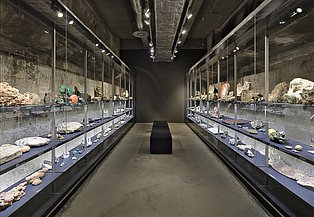
With 20.000 pieces, the Ruhr Museum's mineralogical collection is by no means the museum's largest collection, but it is certainly one of the most beautiful. Hardly anyone can escape the fascination, the richness of colour and form of these stones, which sparkle differently in every light, round, angular, jagged, bizarre and graceful, in short, taking on every imaginable and unimaginable colour and form.
But minerals are more than beautiful objects that inspire people's aesthetic perception and imagination. They are at the same time witnesses of the earth's history and raw materials from which the human creation of value and shaping of the world is fed to a not inconsiderable extent. In this respect, minerals have always attracted the attention, indeed the desire, of very different groups, including not only, but also, collectors. And it is significant that minerals were already part of the first phase of the Ruhr Museum over a hundred years ago. Mineralogical duplicates of the Krupp collection were already on display when the then Museum of the City of Essen was founded, and from then on they were collected primarily with a view to the importance of coal, iron and steel in what was once Europe's largest coal and steel region.
Ernst Kahrs, the first full-time director of the museum, was already a natural scientist and assembled a considerable mineralogical collection, which is particularly important for the Ruhr area, and this has remained a good tradition under all his successors. A special role was certainly played by the donation of the private Hänisch collection to the citizens of Kupferdreh, which led to the establishment of a separate Mineralien-Museum as a branch of the Ruhr Museum in 1984 and which is currently celebrating its 37th anniversary.
Part of the Mineralogical Collection can be seen in the Ruhr Museum's Permanent Exhibition.
Large parts of the Mineralogical Collection can now be seen in the Schaudepot as part of a guided tour.